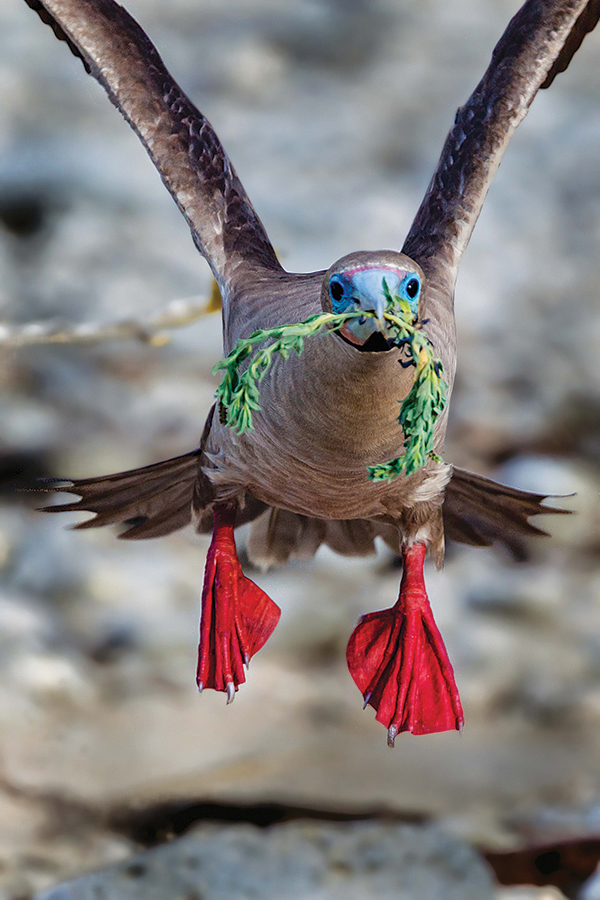How a second-grade classroom can be like the Galápagos Islands

The red-footed booby is among the species that inspire second-grade teacher Jennie Warmouth to connect her students to the natural world. Photo by David Jaffe.
I am a second-grade teacher and an empathy researcher with a Ph.D. in educational psychology. I am also a Grosvenor Teacher Fellow with National Geographic and Lindblad Expeditions. The competitive program brings teachers on field experiences that we can use to connect our classrooms and communities with geographies around the world.
Teaching remotely, hybrid and now in-person during the COVID-19 pandemic has challenged me to innovate new methods of project-based learning to connect my students with one another and our natural world. In March of 2020, as I prepared to teach online, I reflected upon my pre-pandemic experience teaching remotely from Arctic Svalbard while on a National Geographic and Lindblad Expeditions journey. My objective then was to teach our school community about polar bears, climate change and the impact of microplastics on the ocean. Our 600-student population followed along in real time as I posted images online each day from the field. Upon my return, my inspired students changed our school’s single-use plastic policy and hosted an international design competition to encourage other children to generate visual art aimed at Arctic conservation.
Moving into remote teaching in 2020, I linked our global study of polar bears to our own local black bear population. After learning about three orphaned cubs receiving lifesaving care at the Progressive Animal Welfare Society just 1½ miles from our school, my students hosted a virtual schoolwide read-a-thon that raised $2,000 to benefit the bears. They also designed and delivered natural foraging piñatas stuffed with fruits, nuts, seeds and larvae to help teach the cubs to find food in advance of their release back into the wild. This other-oriented work united my young students through a sense of authentic purpose and collaboration despite neither sharing physical space with one another nor the bear cubs.
At the end of the past school year, I received a generous invitation from Lindblad Expeditions to spend my summer break aboard the National Geographic Endeavor II in the Galápagos Islands. I knew that this would be a once-in-a-lifetime opportunity to learn alongside renowned National Geographic photographer Annie Griffiths, restoration ecologist Heinke Jäger of the Charles Darwin Foundation and biologist Jon Whitman of Brown University. As an empathy researcher interested in the psychology of human-animal interaction, I enjoyed a dream come true!
The Galápagos are situated in the Pacific Ocean, approximately 600 miles off the coast of Ecuador. They are best known for their diverse array of plant and animal species, many of which are not found anywhere else in the world. These include the giant Galápagos tortoise, the marine iguana, the Galápagos penguin and the many subspecies of finches central to Charles Darwin’s theory of evolution.
Nothing could have prepared me for the deep wonder I felt while exploring this uniquely isolated ecosystem. I mingled with blue-footed boobies and observed fluffy frigatebird chicks hatching. I witnessed waved albatrosses engaging in complex courtship rituals and passed by piles of sneezing marine iguanas in repose. I walked alongside a 200-year-old giant tortoise and watched as shadowy sharks devoured schools of fish illuminated by our ship’s stern at night.
I was awestruck by how close some of the wild inhabitants of the archipelago would try to get. This was especially so underwater. My daily snorkeling adventures were punctuated by rafts of swirling juvenile sea lions that playfully mirrored my movements and nibbled on my fins. On one such snorkeling event with several other explorers, a curious Galápagos penguin suddenly popped up in the middle of our circle! He swam from person to person—responding to each of our goggled faces with a head tilt and chirp before diving back down underwater, only to pop up again and again. He was especially interested in the spherical lens on my GoPro camera. He examined it quizzically before pecking seven holes in it with his tiny beak!
Remembering our commitment to stay six feet from the wildlife, I paddled away to create space for the plucky penguin. My stomach dropped as my eyes registered the whitetip reef shark gliding by. Looking down, I caught a glimpse of a marbled ray stirring up sediment as it emerged from its sandy hiding place. To my right, a milky eyed sea lion was diving in perfect figure eights around a gliding sea turtle. I surfaced for a breath only to be met by a yellow-crowned heron and a Galápagos hawk. Slack-jawed and speechless, I turned to our naturalist, Christian Saa, who was born and raised on the island of Isabela. He smiled and said, “Jennie, THAT was spectacular … even for the Galápagos!”
Now back in the U.S. and teaching in person with strict three-foot physical distancing and mask protocols in place, I am inviting my students—who by their nature are not great at social distancing—to imagine their individual desks as distinctive islands that together comprise our own classroom archipelago. They are hardy and flexible scholars who, like Darwin’s finches, will evolve this year to occupy their own unique niches in order to thrive in our classroom community and beyond.